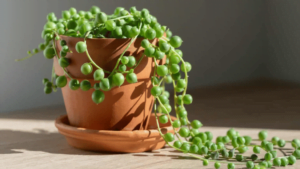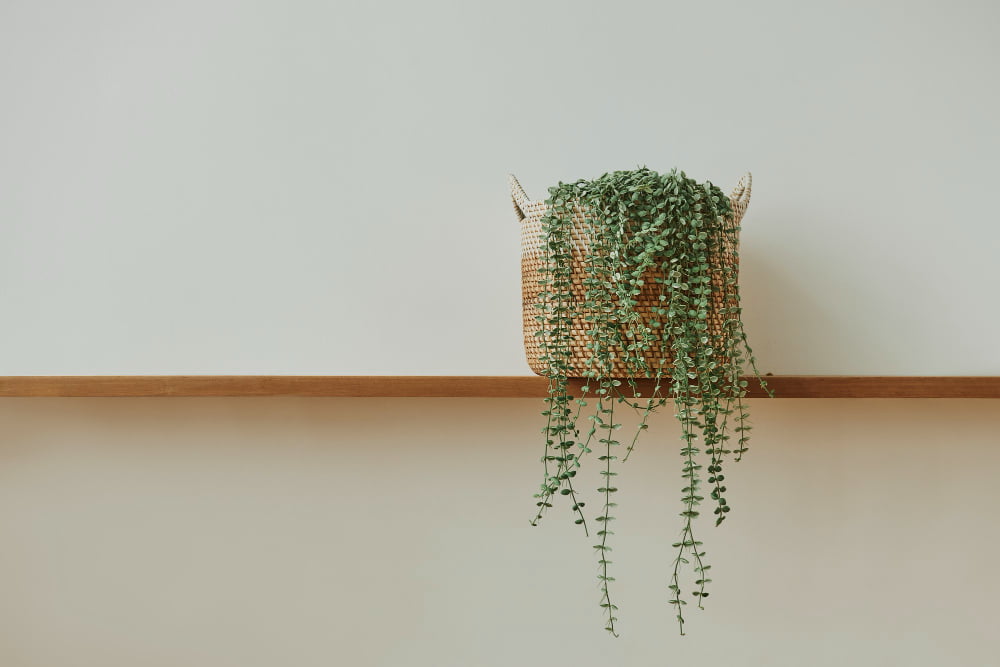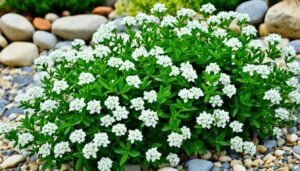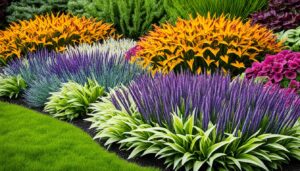Introduction: A Glimpse into the String of Pearls
The indoor plant string of pearls (Senecio rowleyanus) is a fascinating, known for its unique cascading vines filled with spherical, pea-like foliage. It’s a sought-after addition to any plant collection due to its peculiar appearance and the elegance it brings to interior spaces. In this comprehensive review, we’ll delve into the care requirements and secrets to ensuring your String of Pearls thrives.
String of Pearls (Senecio rowleyanus) Indoor Plant Details
| Specification | Details |
|---|---|
| Common Names | String of Pearls, String of Beads, Rosary String, Tangled Tears |
| Botanical Name | Senecio rowleyanus |
| Family | Asteraceae (Daisy family) |
| Plant Type | Succulent |
| Mature Size | Up to 2-3 feet in length (trailing) |
| Sun Exposure | Bright, indirect light |
| Soil Type | Well-draining, cactus or succulent mix |
| Soil pH | 6.0 to 7.5 (Slightly acidic to slightly alkaline) |
| Bloom Time | Winter (though blooms are infrequent indoors) |
| Flower Color | Small white flowers |
| Hardiness Zones | 10-12 (typically grown as an indoor plant outside these zones) |
| Native Area | Southwest Africa |
String of Pearls (Senecio rowleyanus) Care
A n integral part of ensuring your String of Pearls flourishes is understanding its native habitat. Originating from Southwest Africa, it’s adapted to long dry seasons, interspersed with infrequent rainfalls. Therefore, your care routine should mimic these conditions.
n integral part of ensuring your String of Pearls flourishes is understanding its native habitat. Originating from Southwest Africa, it’s adapted to long dry seasons, interspersed with infrequent rainfalls. Therefore, your care routine should mimic these conditions.
Light Requirements
Bright, indirect light is the sweet spot for the String of Pearls. While it can tolerate direct sunlight for short periods, prolonged exposure can cause its vibrant green pearls to turn a reddish-purple or even get sunburned. Ensure your plant is near a window, but out of the harsh midday sun.
Soil Composition
Just as in its natural habitat, the String of Pearls prefers well-draining soil. A cactus or succulent mix is ideal. The presence of sand or perlite ensures rapid drainage, preventing root rot.
Watering Guide
Watering should be done sparingly. Wait until the soil is thoroughly dry before watering again. Overwatering is a common pitfall, leading to mushy pearls and potential root rot.
Temperature and Humidity
This plant thrives in room temperature, anywhere from 70-80°F. Lower temperatures can stress the plant. It’s also quite drought-resistant, so high humidity levels are unnecessary.
Fertilization Methods
While the String of Pearls isn’t particularly hungry, it appreciates light feeding during its growing season. A diluted cactus or general-purpose fertilizer every month will suffice.
Different Varieties of String of Pearls
While the traditional green variety is popular, there’s also a variegated type with streaks of white, adding an extra charm.
Pruning Techniques
Pruning isn’t mandatory but helps in maintaining its aesthetic appeal. Simply snip off overgrown or dead tendrils.
Propagating String of Pearls
Propagation is straightforward. Cut a healthy strand, let it air dry for a few hours, then place it in well-draining soil.
Overwintering Your Plant
Winter demands minimal watering. It’s also a good idea to keep the plant in a slightly cooler spot, away from direct heaters.
Common Pests & Plant Diseases
Mealybugs and aphids can be occasional visitors. Wipe with a soapy water mix to keep them at bay. Root rot, due to overwatering, is a common ailment.
Encouraging Blooming in indoor plant string of pearls
Though rare, String of Pearls can bloom, producing small white flowers. Ensuring adequate light and proper watering can encourage this process.
Four Common Problems and Their Solutions
String of Pearls is undoubtedly a unique plant, but like all plants, it can run into common problems. Being able to diagnose and rectify these issues promptly will ensure that your plant remains vibrant and healthy. Let’s delve deeper into these four common problems and their solutions:
1. Yellowing Pearls
Problem: The pearls start to take on a pale yellow color.
Cause: Overwatering. String of Pearls is a succulent, which means it’s accustomed to environments where water is scarce. Overwatering can easily damage the plant’s roots, leading to a lack of nutrient absorption and, consequently, yellowing pearls.
Solution: It’s crucial to let the soil dry out completely before watering again. When you water, ensure you water deeply so the roots can access moisture, but always check the soil moisture level first. Using a pot with drainage holes can also help prevent water from stagnating at the bottom.
2. Shriveled Pearls
Problem: The pearls appear shriveled or deflated.
Cause: Under-watering. While the String of Pearls is drought-resistant, it still requires moisture to thrive. If the pearls are shriveling, it’s a sign that they aren’t getting the water they need.
Solution: Increase your watering frequency slightly but do so with caution. It’s better to water in small amounts and observe the plant’s response rather than risk overwatering. If you’re unsure about the moisture level, use a finger or moisture meter to gauge the soil’s dryness.
3. Mushy Pearls
Problem: The pearls become soft and mushy to the touch.
Cause: Root rot. This is typically a consequence of the plant sitting in water for extended periods, causing the roots to decay.
Solution: First, inspect the plant’s roots. If they’re brown and smell unpleasant, they’re rotting. Remove the affected roots, and replant the healthy parts in fresh, well-draining soil. In the future, ensure proper soil drainage. Using a cactus or succulent mix can help, as these soil types don’t retain too much moisture. Again, pots with good drainage holes are beneficial.
4. Reddish Pearls
Problem: The pearls develop a reddish or purple hue.
Cause: Excessive sunlight. Though the String of Pearls enjoys bright light, direct sunlight, especially during the intense midday sun, can cause sunburn.
Solution: Relocate your plant to an area where it receives bright but indirect sunlight. If it’s near a south-facing window, consider moving it further into the room or using sheer curtains to diffuse the light. Another solution is placing it near east or west-facing windows where the sunlight is less intense.
Being proactive and observing your String of Pearls regularly will help you notice these issues early on, allowing you to make the necessary adjustments before the problems escalate. Remember, it’s all about balancing the care to match the plant’s native conditions.
When Indoor Plant String Of Pearls Show Rapid Decline
When your String of Pearls faces a swift decline, it’s often a sign of a severe underlying issue. Quickly address potential causes:
- Root Rot: Ensure the plant isn’t sitting in water and the soil drains well.
- Pests: Examine the pearls and stems for any insect activity.
- Watering Patterns: Ensure you’re not overwatering or underwatering, which can both stress the plant.
Unraveling the Mystery: Conclusion
The String of Pearls, with its whimsical appearance, is a gem for indoor plant enthusiasts. With the correct care, it can become a long-lasting addition to your home.
Frequently Asked Questions
- Is the String of Pearls toxic? Yes, it can be toxic if ingested. Keep away from pets and children.
- How often should I repot? Repotting every 2-3 years is ideal, or when the plant outgrows its container.
- Why are my pearls losing their round shape? This is often due to inadequate watering. Adjust accordingly.
- Can it grow outdoors? In warmer climates, it can be grown outdoors. However, it’s primarily an indoor plant.
So, if you’re looking for an alluring plant that’s also resilient, the String of Pearls might be your perfect match!










